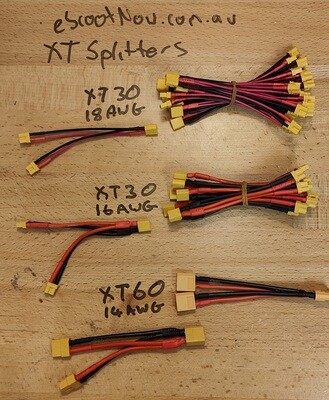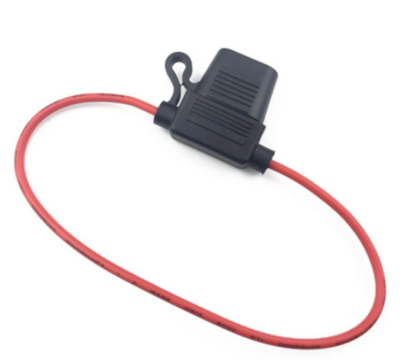Extensive online catalogue servicing new and existing Now Club members & trade/ABN | eSN2026#JP-CN | Group Ride Guide | On The Run Workshop |
TurboCharge Fast Charger 54.6/58.8/67.2/84V for 48/52/60/72V GX16-3F/RGX16-2M 7-5A [MC450T]
SKU TURBOCHARGE-MC450T/0840-84.0V5A-GX16-3F-13
AU$171.82
Bulk pricing available for quantities of 2 units or more
Over-engineered for resilliancy.
Variant
Please choose
Scooter make / model / serial / voltage and battery Ah
Enter your text
In stock: 8 available
1
Buy more, save more
| Quantity | Price per item | Discount |
| 2 items | AU$154.55 | 10% off |
| 5 items | AU$141.82 | 17% off |
Save this product for later
Customer reviews
Reviews only from verified customers
No reviews yet. You can buy this product and be the first to leave a review.
TurboCharge Fast Charger 54.6/58.8/67.2/84V for 48/52/60/72V GX16-3F/RGX16-2M 7-5A [MC450T]
Product Details
Brand: TurboCharge by eScootNow [Mingchong]
- TurboCharge Fast MC is eSN's over-engineered charger offering the ultimate in resiliency and reliability
- Available in four voltage variant::
- MC450T-0546 54.6V 7A (382.2 watts) for 48V system.
- MC450T-0588 58.8V 7A (411.6 watts) for 52V system.
- MC450T-0672 67.2V 6A (403.2 watts) for 60V system.
- MC450T-0840 84.0V 5A (420.0 watts) for 72V system.
- With choice of connector:
- GX16 3-pin female plug (as pin 1 +ve, pin 3 -ve) which is adopted by most common makes and models of earlier model scooters that have charging ports like this.
If pin 1 +ve, pin 2 -ve is required include comment at checkout and a complimentary patch lead will be included. - GX16 Reverse 2-pin male plug (RGX16 as pin 1 +ve, pin 2 -ve) which is adopted on modern NAMI models as alternative to genuine NAMI chargers for the two pin charging ports like this.
- GX16 3-pin female plug (as pin 1 +ve, pin 3 -ve) which is adopted by most common makes and models of earlier model scooters that have charging ports like this.
- Input cable accepts 110-240 volts, therefore suitable for global use. Features a hard wired and thick cable with Australian 3-pin power cable (1.4 meter length). A panel mount rocker switch allows for AC input switching on/off.
- Output cable is thicker again with 2 x 1.5mm cores in a heavy protective insulation with generous 1.1 meter length. In contrast, the TurboCharge YZ model has 2 x 1.0mm cores.
- 50mm fan (secured with 4 screws). LED charging status indicator switches from green to red when charging.
- Chargers have certification to ISO testing, those required for EESS Australian compliance for Regulatory Compliance Mark (RCM) with appropriate proof of RCM compliance certification.
- MC450T series is to 450 watts (standard escooter chargers are typically 130 watts). Manufactured by Shenzhen Qiyang International Trade Co., Ltd. (QY Power) for custom order spec by eScootNow.
- Weight with cables 1.27kgs in a narrow footprint 215mm x 90mm x 58mm black alloy enclosure (120 grams heavier than TurboCharge YZ, reflecting the over-engineered design).
- For your safety, include your scooter's make / model / serial / voltage and battery Ah capacity as order comment on checkout so that the appropriate voltage can checked to best of our ability as part of order fulfilment. Remember some makes have models that are available in variants that have different voltages and inappropriate selection of higher voltages is a common cause of thermal runway and house fires folks.
Notes:
- Although "fast chargers" are quick, they typically do not exceed the recommended charge rate of the cells, except for small capacity batteries (e.g. Chinese 18Ah packs). You may also need to check the internal fuse in the scooter is sufficiently rated as many are by default only 5 amp which only caters for stock 2 amp chargers.
- Comparative image of this charger with the TurboCharge YZ (silver enclosure) and the factory stock NAMI charger. Note the presence of switch on the Fast MC, largest fan, largest ventilation and smallest footprint.
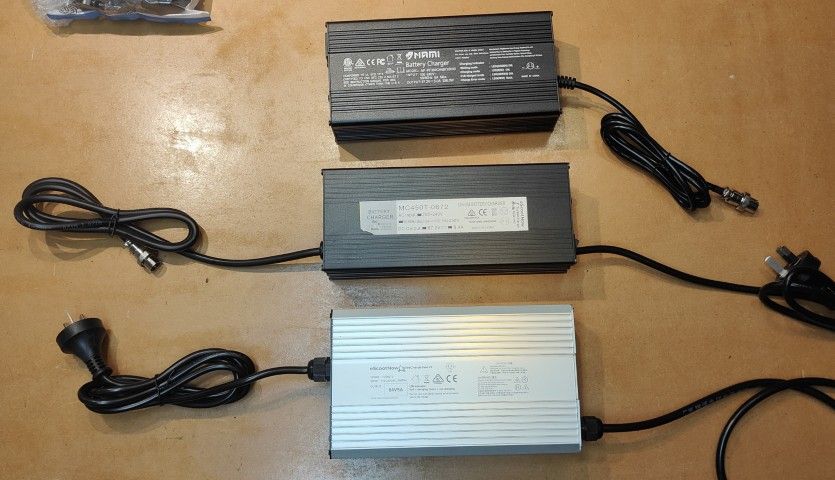
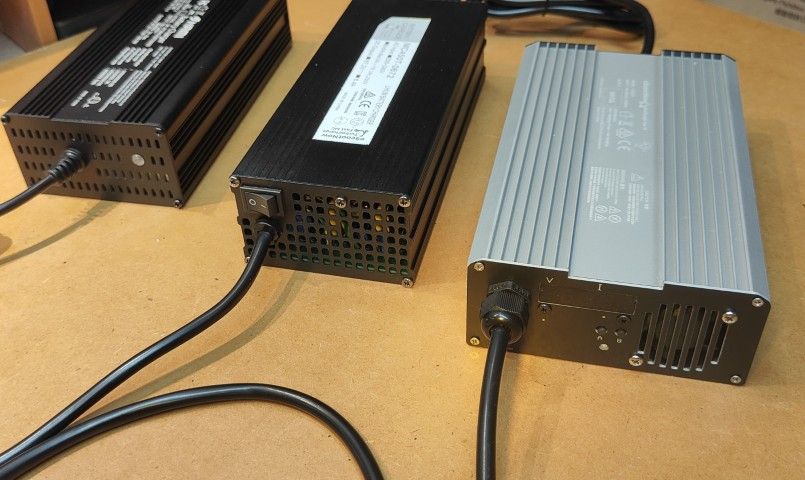
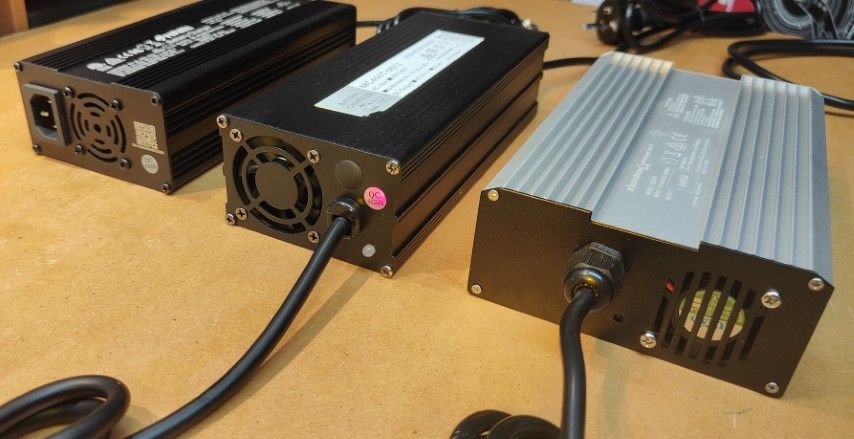
- Part of the eSN's TurboCharge range, as shown 2nd from right:
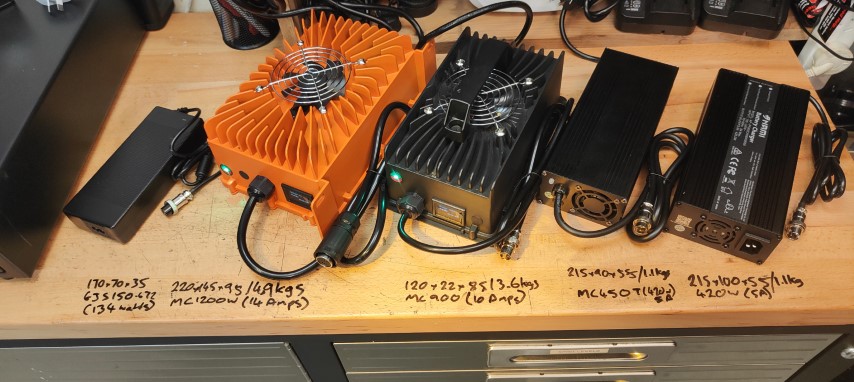
- SKU naming convention:
The product SKU designates the three key particulars of voltage, charger and plug.
Syntax: XXXX VVVvv AAA ppppp N G 00 Example: 0672 67.2V 6A GX16 3 F 13 Denotes: Model suffix Voltage Amps (current) Plug series Plug pin count Plug gender
(of the pins)+ve / -ve pins - Unboxing video of the earlier red model samples. These versions had a panel mount fuse and were red in colour. A couple of red's remain in product image to show the nameplate as the photo's of black ones are without label
Also published as Facebook video at eScootNow - The Facebook Group. - MC series OEM is also adopted by AC-DC Australia, observed under Matron brand.
- Manufacturer model vs output list:
Note some chargers have nameplate specifying only 200-240 volts input, factory has confirmed 110-240 volts is supported as per the technical specification. - Regulatory Compliance Mark (RCM)
The Electrical Compliance Mark indicates compliance with EESS (Electrical Equipment Safety Scheme). For electrical safety, in-scope electrical equipment must not be sold unless the item is marked with the RCM in compliance with AS/NZS 4417.1 & 2.
Responsible Suppliers, equipment and certifications (including certificate number) of are registered with Electrical Regulatory Authorities Council (ERAC).
There is a public search tool to check registration and compliance, the Certificate Number is printed underneath the RCM logo on equipment nameplate which looks like this: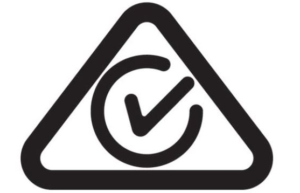
EARC Equipment safety requires an Australian based assessor to issue certificate of RCM compliance. The assessment considers a number of standards and guides such as::- Australian/New Zealand Standards:
(i) AS/NZS 3000, Wiring Rules.
(ii) AS/NZS 3820, Essential safety requirements for low voltage electrical equipment.
(iii) AS/NZS 4417, Marking of electrical products to indicate compliance with regulations AS/NZS 4417.1, Part 1: General rules for use of the mark.
(iv) AS/NZS 4417.2, Part 2: Specific requirements for electrical safety regulatory applications. - International Standards and Guides (mostly ACMA for EME):
(i) ISO/IEC 17000, Conformity assessment -- Vocabulary and general principles.
(ii) ISO/IEC 17025, General requirements for the competence of testing and calibration laboratories.
(iii) ISO/IEC 17050, Conformity assessment - Supplier's declaration of conformity.
(iv) ISO/IEC Guide 2, Standardization and related activities -- General vocabulary
(v) ISO/IEC Guide 65, General requirements for bodies operating product certification systems.
(vi) ISO/IEC Guide 67, Conformity assessment – Fundamentals of product certification.
(vii) Joint Accreditation System of Australia and New Zealand.
(viii) JAS-ANZ Procedure 15, General Requirements for Bodies operating Product Certification Systems (identical to IAF GD 5).
Applicant (certification): AusRCM
Brand/Trade Name: MINGCHONG
Model Number: MC450T-0292 (and other MC450T variants including MC450T-0294, MC450T-0996, MC450T-0664, MC450T-0876, MC450T-0830, MC450T-0756, MC450T-0672, MC450T-0365, MC450T-0924, MC450T-0584, MC450T-0588, MC450T-0954, MC450T-0438, MC450T-0966, MC450T-0540, MC450T-1008, MC450T-0546, MC450T-0415, MC450T-0882, MC450T-0714, MC450T-0336, MC450T-0747, MC450T-0738, MC450T-0730, MC450T-0504, MC450T-0735, MC450T-0332, MC450T-0547, MC450T-0798, MC450T-0842, MC450T-0630, MC450T-0420, MC450T-0581, MC450T-0840, MC450T-0498, MC450T-0657, MC450T-0405)
Equipment Class: Level 3
Certificate Holder: Guangzhou Mingchong Technology Co.,Ltd
Status: Approved
Expiry Date: 13/10/2027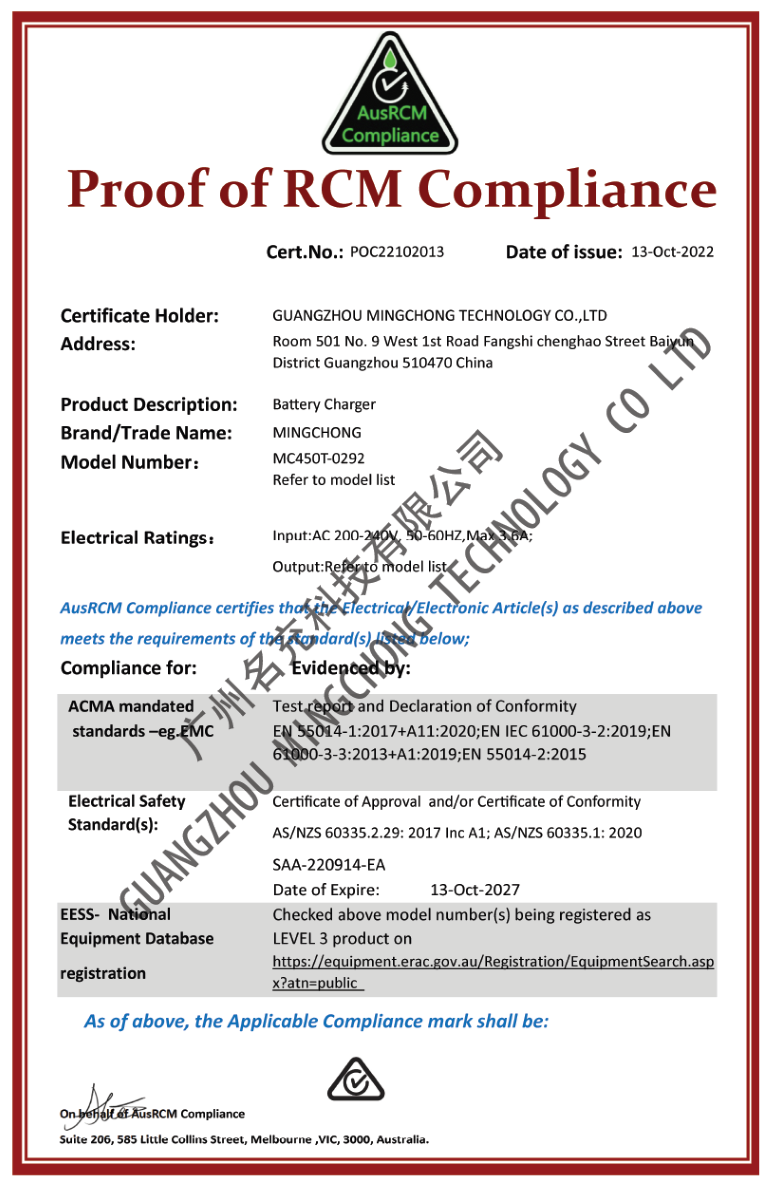
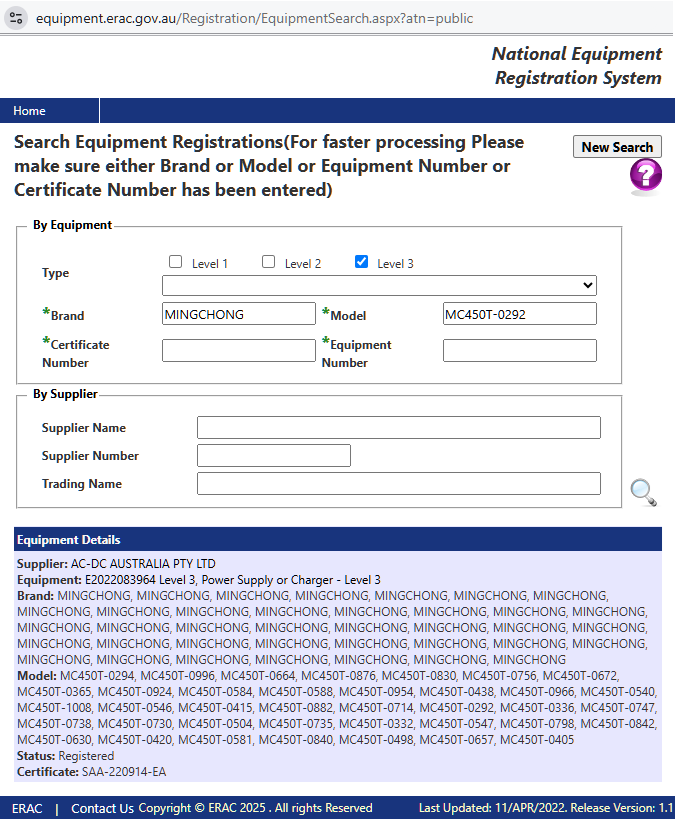
- Australian/New Zealand Standards:
You May Also Like
![TurboCharge Fast Charger 67.2/84.0V for 60/72V GX16-3F 6/5A [YZ500] TurboCharge Fast Charger 67.2/84.0V for 60/72V GX16-3F 6/5A [YZ500]](https://d2j6dbq0eux0bg.cloudfront.net/images/60508924/5104168544.jpg)
TurboCharge Fast Charger 67.2/84.0V for 60/72V GX16-3F 6/5A [YZ500]
TurboCharge Fast Charger 67.2/84.0V for 60/72V GX16-3F 6/5A [YZ500]
With voltage and current display.
AU$176.36
![TurboCharge Semi-Fast Charger 84.0V for 72V GX16-3F 2.95A [XVE248] TurboCharge Semi-Fast Charger 84.0V for 72V GX16-3F 2.95A [XVE248]](https://d2j6dbq0eux0bg.cloudfront.net/images/60508924/products/804023884/5474410826.jpg)
TurboCharge Semi-Fast Charger 84.0V for 72V GX16-3F 2.95A [XVE248]
TurboCharge Semi-Fast Charger 84.0V for 72V GX16-3F 2.95A [XVE248]
Fastest of all fan-less chargers.
AU$113.64
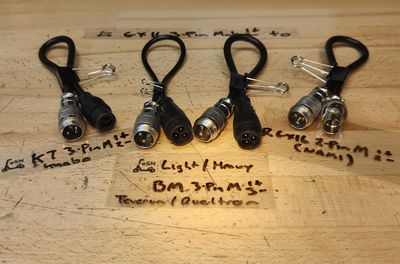
TurboCharge Conversion Cable GX16 3-Pin Male
TurboCharge Conversion Cable GX16 3-Pin Male
Allows chargers with older GX16 connector to connect to modern eScooters of Langfeite/Dragon, Kaabo, NAMI & Dualtron/Teverun.
AU$29.09
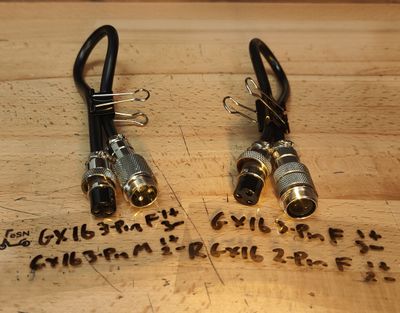
TurboCharge Conversion Cable GX16 3-Pin Female
TurboCharge Conversion Cable GX16 3-Pin Female
Supports pin 1/2 configuration / allows NAMI 2-pin charger to connect to eScooters with older 3-pin connectors.
AU$25.45
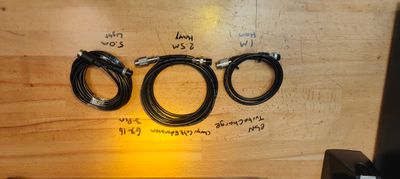
TurboCharge Extension Cable (GX16 3-Pin - 1m/2.5/5m)
TurboCharge Extension Cable (GX16 3-Pin - 1m/2.5/5m)
Add length to your charger cable
AU$20.91
![TurboCharge Charger 54.6V for 48V GX16-3F 1.5/2A [Gojusin | Xinqihang] TurboCharge Charger 54.6V for 48V GX16-3F 1.5/2A [Gojusin | Xinqihang]](https://d2j6dbq0eux0bg.cloudfront.net/images/60508924/4297913990.jpg)
TurboCharge Charger 54.6V for 48V GX16-3F 1.5/2A [Gojusin | Xinqihang]
TurboCharge Charger 54.6V for 48V GX16-3F 1.5/2A [Gojusin | Xinqihang]
Typically suited to early model Dragon Cyclone/GTR/GTS including V2, Slayer and Zero 8&9 etc.
AU$58.18
![TurboCharge Charger 58.8V for 52V GX16-3F 2A [Gojusin GJS150-5880200] TurboCharge Charger 58.8V for 52V GX16-3F 2A [Gojusin GJS150-5880200]](https://d2j6dbq0eux0bg.cloudfront.net/images/60508924/4196661950.jpg)
TurboCharge Charger 58.8V for 52V GX16-3F 2A [Gojusin GJS150-5880200]
TurboCharge Charger 58.8V for 52V GX16-3F 2A [Gojusin GJS150-5880200]
Typically suited to Dragon Raptor and early models of Cyclone etc.
AU$61.82
![TurboCharge Charger 67.2V for 60V GX16-3F 2A [Gojusin GJS150-6720200] TurboCharge Charger 67.2V for 60V GX16-3F 2A [Gojusin GJS150-6720200]](https://d2j6dbq0eux0bg.cloudfront.net/images/60508924/5474595751.jpg)
TurboCharge Charger 67.2V for 60V GX16-3F 2A [Gojusin GJS150-6720200]
TurboCharge Charger 67.2V for 60V GX16-3F 2A [Gojusin GJS150-6720200]
Typically suited to older models of Kaabo Mantis, Wolf, 60V Zero 10X etc.
AU$61.82
![TurboCharge Charger 84.0V for 72V GX16-3F 1.5/2A [XVE128 | Hyleton] TurboCharge Charger 84.0V for 72V GX16-3F 1.5/2A [XVE128 | Hyleton]](https://d2j6dbq0eux0bg.cloudfront.net/images/60508924/3495984132.jpg)
TurboCharge Charger 84.0V for 72V GX16-3F 1.5/2A [XVE128 | Hyleton]
TurboCharge Charger 84.0V for 72V GX16-3F 1.5/2A [XVE128 | Hyleton]
Typically suited to older models of Kaabo Wolf (72V models) etc.
AU$71.82
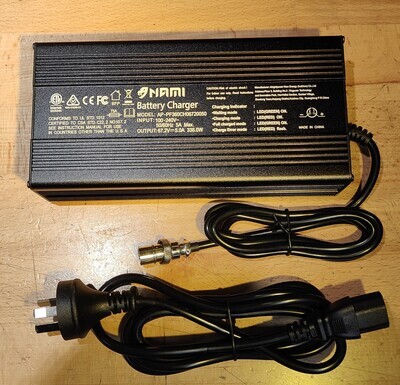
NAMI Blast and Klima Charger 67.2V for 60V RGX16-2M 5A
NAMI Blast and Klima Charger 67.2V for 60V RGX16-2M 5A
[Alrightpower AP-PF3600CH06720050]
AU$177.27
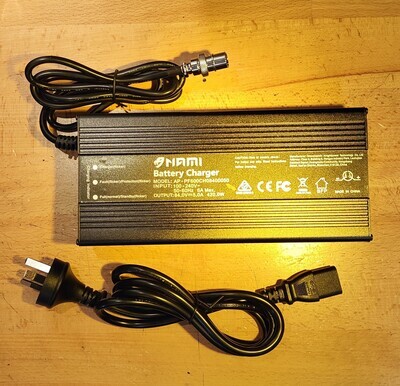
NAMI Burn-e Charger 84.0V for 72V RGX16-2M 5A
NAMI Burn-e Charger 84.0V for 72V RGX16-2M 5A
[Alrightpower AP-PF3600CH08400050]
AU$226.36
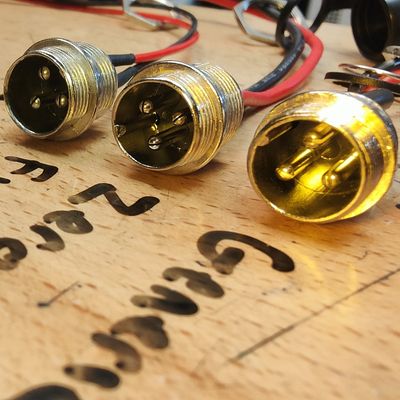
GX16 eScooter Charging Port Connector (3 pin panel socket to XT30 or XT60 / 2&3 pin plug/socket)
GX16 eScooter Charging Port Connector (3 pin panel socket to XT30 or XT60 / 2&3 pin plug/socket)
Suit the common 3-pin eScooters or plug on NAMI charger.
AU$9.55

NAMI Charging Port
NAMI Charging Port
Panel socket for charging, suits Burn-e, Blast and Klima.
AU$17.73
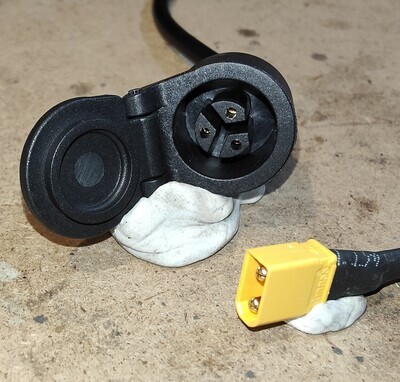
Kaabo LT 3-pin Female charging port (panel socket) with hinged cover
Kaabo LT 3-pin Female charging port (panel socket) with hinged cover
Newer moulded Kaabo charging port.
AU$14.55
Display prices in:AUD
![TurboCharge Fast Charger 54.6/58.8/67.2/84V for 48/52/60/72V GX16-3F/RGX16-2M 7-5A [MC450T] TurboCharge Fast Charger 54.6/58.8/67.2/84V for 48/52/60/72V GX16-3F/RGX16-2M 7-5A [MC450T]](https://d2j6dbq0eux0bg.cloudfront.net/images/60508924/5103102165.jpg)


